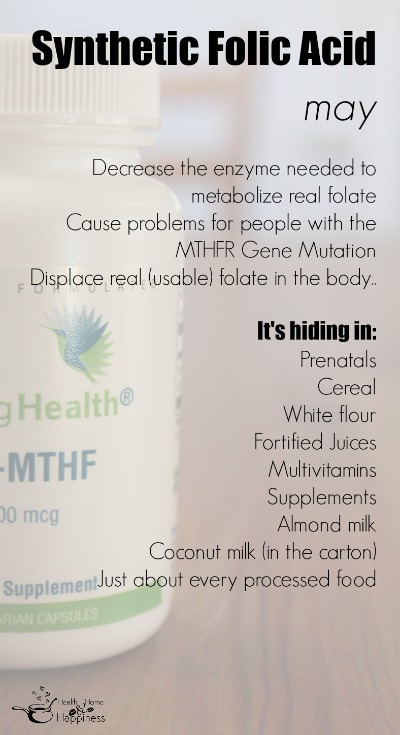
“Let’s take a look at your supplements…” I say to a friend who struggles with leaky gut, autoimmune problems, and attention deficit. “Can you text me pictures of the ingredient list and nutrition facts of them all?”
Despite only using ‘good’ brands of supplements from the health food store, we found synthetic folic acid in her B-complex, multivitamin, and the green juice she was drinking daily. When someone has multiple unexplained health problems, and is going through the trouble of dietary intervention switching to a methylated form of folate and eliminating all the synthetic folic acid can be the missing piece of the puzzle.
We are Folic Acid Blind
We are all so used to seeing folic acid on the ingredient list in so many foods and supplements that we’ve become blind to it. Added to grains, cereals, juice, vitamins, and other supplements with the goal of reducing birth defects including spina bifida, the intention behind adding it to food was good.
But the synthetic (less expensive) form that is added to most vitamins, processed food, flour, and cereals is causing problems in those with MTHFR gene mutation who don’t produce enough of the enzyme needed to absorb it (source), and may even cause enzyme deficiencies in those without the MTHFR gene mutation (source).
Folate and Mythyl Folate For Those With Health Problems
As we’ve talked about before, some people will be able to better tolerate folic acid (and other synthetic food additives) better than others. It has to do with the state of your gut, your gene type, and even how genes express themselves.
Most of my readers are interested in natural food and supplements because the status quo is not working for them. And this may be one piece of the puzzle.
Read: Folate, Autism, and Tongue Tie: Why I regret Taking My Prenatal Vitamin
Why is it in our food?
Again, let me remind you that the intention behind adding folic acid to most food in the supermarket and most multivitamins was good- we wanted to decrease the incidence of neural tube defects, and for those eating mostly processed food without any B vitamins added back in, the diet is low in natural folate and the risk of neural tube defects is higher.
But for those who have been consuming too much folic acid and have had the enzymes needed to process it suppressed (source), or are unable to process even small amounts due to fairly common gene mutations (source), this attempt at helping our health is causing similar symptoms to the deficiency that we’re trying to prevent (source).
Where is synthetic folic acid found?
In 1996 the FDA started requiring that folate/folic acid be added to all grain and cereal products.
In its naturally occurring form folate lacks stability in food storage and preparation; however, folic acid is stable and used for supplements and food fortification. – The History of Folic Acid Supplementation
-
- Multi vitamins
-
- B vitamin complexes
-
- Prenatal vitamins
-
- Supplements, especially supplements for energy
-
- Fortified Juice
-
- Fortified almond, soy, rice, or coconut milk
-
- Bread and baked goods from the store
-
- Flour from the store (freshly ground at home is okay)
-
- Products made with flour such as crackers, chips, bread crumbs, pasta.
- Anything labeled ‘fortified’ or ‘enriched’
What should I take instead?
Through gene testing, lab testing, and trial and error, people are finding the correct form and dose of folate for them.
Before you let labs be your final say read: When The Labs Say There is Too Much Folate In Your Blood
Labs and Genetic Testing
Testing for the MTHFR gene mutation can be done through genetic testing. They are also beginning to find that even those without the MTHFR gene mutation can have the enzyme needed to process folic acid into usable folate supressed (source) so the actual gene mutation may not tell the whole story about whether folic acid is good to consume or not.
Labs can measure the amount of folate/folic acid circulating in the blood.
Trial and error
It’s not sexy or expensive, and it doesn’t come with a computer-generated printout for reassurance, but to find the correct form of folate in my own family I use the trial and error approach. This is how we approach supplements, there are too many times that I have tried to adjust supplements based on lab work without noticing any improvement.
This is what our approach looked like:
-
- Remove sources of folic acid for our diet for 1 week (see list above)
- Add in high folate foods and note any improvements over 1 week. (see list below)
-
- Add in 1 capsule of Methyl folate and see if symptoms improve.
-
- If they do not improve or you feel worse, try a different form. Some people can’t do the methyl.
-
- Record symptoms on a simple wall calendar. In our family we note sleep hours, irritability, vocabulary, fatigue, eye contact, skin rashes, fogginess.
-
- Increase by one capsule every few days until we get to the recommended dose of 3/day.
-
- Continue to record symptoms.
-
- Stay on recommended dose for 2 weeks, then use the opposite approach to go down on the dose.
-
- Continue to record symptoms. If symptoms return that were gone, stop going down.
-
- Every 2 weeks try going down on the dose, while continuing to record symptoms. We have found that we only need one capsule every other day and we lose undesirable symptoms (kids not sleeping well, tiredness and fogginess for adults).
- If you feel there is still another piece missing, you can repeat the process with the b12/methyl folate combination.
Foods that are high naturally in natural folate:
Amount of folate per 100 g as per nutritiondata.self.com
- Seaweed, agar – 1010 mcg
- Leeks – 366 mcg
- Sweet green peppers – 229 mcg
- Spinach, raw, 194 mcg
- Sunflower seed kernals, toasted, 238 mcg
- Duck liver – 738 mcg
- Chicken liver – 588 mcg
- Beef liver – 290 mcg
Supplements made with methyl folate, not folic acid:
Quick reminder: I am not a medical professional, this is not medical advice. I am just a mom who is trying to figure out what’s going on in my own family with the information I have available to me. And I want to share, in case it is helpful for you.
Read more:
See all MTHFR/Folic Acid Articles

Folic Acid: Disaster for Your Baby's Health

Sign up here to get all 6 articles about MTHFR, Folate, Folic Acid. See how this relates to autism, tongue tie, and more. Easy to implement ideas- don't miss this essential information.



If the enzymes needed to process folic acid are suppressed or don’t work due to common gene mutations, this would only mean that the body would be unable to use the folic acid. It would simply be eliminated from the body. Why would it cause any health problems?
The problem is that it isn’t eliminated well, because those enzymes are needed to eliminate it from the blood stream as well. The buildup of excess folic acid can cause problems because the body recognizes that there is folic acid in the blood, and isn’t uptaking the needed folate in usable form. They recently linked high serum folic acid (too much folic acid in the blood) with increased autism risk.
Can we get something straight so to not mislead people.
Methylfolate is ALSO synthetic.
You make it sound like synthetic vitamins are horrible, and then go on to recommend synthetic vitamins!!
Sure, natural is always going to be better, but methylfolate is a better synthetic than folic acid, just like sodium ascorbate is a better synthetic vitamin C than ascorbic acid.
Definitely important to know these differences.
Yes, it is, but it’s more easily absorbed than what is in fortified foods.
Methyl folate also can cause problems in some people. Eliminating folic acid, and then eating whole food sources that are not fortified is my recommendation, with supplementation of an easier-to-absorb form of synthic folate if needed.
For those who want a live-source b vitamin, Max B ND from Premier Research Labs is probiotic generated. The vitamins are end-chain, which means they are already methylated.
So the things you have pictured are or are not safe? Your caption says “… Where they are hiding”
Sorry- no, those are all good :) I just needed a picture to go with the article and I didn’t want to post processed food.
Thanks for the clarification…got worried when I saw all the wonderful produce and the meat I usually pick up at Costco. :)
I never thought of checking on my almond milk! I just went over the ingredient list, and I am happy to report that Hiland Unsweetened Original does NOT have folic acid or any form of it at all. :)
Thank you for writing these articles. I have a question, my daughter who has several sensitivities also had lots of gas while nursing when I took my prenatal vitamin. Also, she can’t have dairy so we’ve been doing coconut and almond milk but she still has gas. Could the folic acid in these foods be giving her gas? She had a tongue and lip tie and so do I. We’ve not been tested for MTHFR. New to the MTHFR and just starting my research. All of my kids have had some form of tongue tie, actually getting worse with each one, so in my mind wondering if it’s due to my “build up” of taking prenatals with folic acid.
Hi Ashley, I haven’t heard about the folate/gas connection but I would recommend switching to a prenatal with methyl-folate (Seeking Health brand is my favorite) in any case.
I think that all infant formulas have Folic Acid in them. How do you give methyl folate and methyl B-12 to a nursing infant on commercial formula?
How do you give methyl folate and methyl B-12 to little children? How much do you give them? I cannot find advice on this.
I see truly heart breaking suffering from deficiencies in my family and in many friend’s families. This is so unnecessary. Thank you for being part of the solution and helping society to stop the damages from Folic Acid.
Wonderful article, and coming from a Registered Dietitian, very accurate. Thanks!